Introduction to Greenhouse Orientation
When setting up a greenhouse in the UK, choosing the right orientation is one of the most important decisions for gardeners and growers. The way your greenhouse faces has a direct impact on light exposure, temperature regulation, and ultimately, plant health and productivity. With the UKs unique climate—marked by overcast skies, shorter winter days, and mild summers—maximising available sunlight is key. Understanding how orientation affects these factors can help you make informed choices that ensure your plants thrive all year round. In this article, well explore why greenhouse orientation matters specifically in the UK context and what options work best for different gardening goals.
2. Understanding the UK Sun Path and Climate
When deciding on the best orientation for your greenhouse in the UK, it’s important to first understand how the British climate and sun path affect plant growth. The UK is known for its variable weather, with frequent cloud cover, moderate rainfall, and relatively mild temperatures. Unlike sunnier regions, the UK rarely experiences intense direct sunlight for extended periods, but daylight hours can be long in summer and short in winter.
The movement of the sun across the UK sky also plays a significant role. The sun rises in the east and sets in the west, but its arc is lower in winter and higher in summer. This means that during summer months, greenhouses receive more overhead light, while in winter, sunlight enters at a shallower angle from the south. These factors influence how much light reaches your plants throughout the year.
| Season | Sun Path Direction | Light Intensity | Daylight Hours (Approx.) |
|---|---|---|---|
| Winter | Low arc, mostly from south | Low | 7-8 hrs |
| Spring/Autumn | Medium arc, east to west via south | Moderate | 10-14 hrs |
| Summer | High arc, nearly overhead | High | 16-18 hrs |
This unique pattern of sunlight exposure makes orientation decisions particularly important for UK gardeners. By considering both seasonal changes and local weather conditions, you can position your greenhouse to make the most of available light—crucial for healthy plant growth even during those famously grey British days.

3. North-South Orientation: Pros and Cons
Positioning a greenhouse along a north-south axis means the longer sides face east and west. In the UK, this orientation has some distinct advantages. One main benefit is that both sides of the greenhouse receive sunlight at different times of day—east in the morning and west in the afternoon. This helps distribute light more evenly across all plants, which can be especially useful if you have rows of crops or benches. Even light exposure encourages balanced plant growth and helps to avoid shading issues that can occur with other orientations. On cloudy or short winter days, every bit of available light counts, making this orientation appealing for keen UK gardeners.
However, there are some potential drawbacks to consider. In certain regions or during the winter months, when the sun is lower in the sky, a north-south oriented greenhouse may not maximise daily sunlight as efficiently as an east-west one would. This can result in slightly cooler conditions inside the greenhouse, which could slow plant development during colder periods. Additionally, if your garden is sheltered or overshadowed on one side (for example, by fences or trees), a north-south layout might not take full advantage of your sites unique light patterns. Careful site assessment is crucial to ensure this orientation works best for your specific location.
4. East-West Orientation: Pros and Cons
Choosing an east-west orientation for your greenhouse is a popular option among UK gardeners, especially in smaller gardens or where the shape of the plot dictates the layout. This orientation means that the longer sides of the greenhouse face north and south, while the ends face east and west. Here, we weigh up the main advantages and disadvantages of this layout in the context of Britain’s unique climate.
Advantages of East-West Orientation
- Maximises Winter Sunlight: During the colder months, sunlight comes from a lower angle in the south. An east-west axis allows more even distribution of light along the length of the greenhouse, which can be crucial for plant growth during short winter days.
- Ideal for Winter Crops: If you plan to grow winter vegetables or start seedlings early in spring, this orientation helps capture valuable morning and midday sun, giving plants a boost when they need it most.
- Suits Narrow Plots: Many UK gardens are long and narrow; an east-west oriented greenhouse often fits better without shading other parts of the garden.
Disadvantages of East-West Orientation
- Summer Overheating Risk: With prolonged exposure to southern sunlight on one side, greenhouses can become too warm in summer. Without good ventilation, this may stress plants or require additional shading.
- Uneven Light Distribution: Some crops at the northern edge may receive less light compared to those nearer the southern side, potentially leading to uneven growth if space is not used thoughtfully.
Summary Table: East-West Orientation Pros and Cons
| Pros | Cons |
|---|---|
| – Maximises winter light – Suits long, narrow UK gardens – Favourable for early sowing |
– Risk of overheating in summer – Potential for uneven light – May need extra shading/ventilation |
Is East-West Best for You?
If your primary concern is maximising sunlight during the UKs darker months or fitting your greenhouse into a narrow space, an east-west orientation could be ideal. However, remember to plan for adequate ventilation and consider shade solutions for hot spells to ensure your plants thrive all year round.
5. Practical Considerations for British Gardeners
Choosing the right orientation for your greenhouse in the UK involves more than simply deciding between north-south or east-west. Local factors can significantly influence which layout will work best for your space and plants.
Shade from Surroundings
Many British gardens are surrounded by fences, hedges, or neighbouring buildings that cast shade during parts of the day. Its essential to position your greenhouse where it will receive the maximum possible sunlight, especially in winter when the sun is lower. Watch how shadows move across your garden throughout the day and year before settling on an orientation.
Prevailing Winds
The UKs unpredictable weather means wind can be a real challenge. Strong winds from the west and south-west are common, particularly in exposed areas. Placing your greenhouse so the narrowest side faces into the prevailing wind can reduce heat loss and structural stress. Additionally, consider nearby trees or structures that might offer shelter without casting too much shade.
Available Space
Garden sizes vary greatly across Britain, from compact city plots to sprawling country lawns. Sometimes, your available space dictates orientation more than anything else. Measure carefully to ensure you leave enough room for access paths and maintenance, and try to avoid placing your greenhouse under overhanging branches or too close to walls that may block light or restrict airflow.
Access to Utilities
If you plan on using electricity or water inside your greenhouse, think about how easily these services can reach your chosen site. A practical location with easy access to mains connections can save time and money down the line.
Summary
No two British gardens are exactly alike, so weigh up these practical considerations alongside optimal sunlight exposure when choosing your greenhouse’s orientation. The right balance will help you get the most out of your growing season, whatever the UK weather brings.
6. Conclusion: Making the Best Choice for Your Garden
Choosing the right orientation for your greenhouse in the UK can make a real difference to your gardening results. Based on our findings, both north-south and east-west orientations have their benefits, but your decision should consider the specifics of your garden and what you plan to grow. For most UK gardeners, a north-south orientation generally allows for more balanced sunlight throughout the day, especially during spring and autumn when light levels are lower. This can help promote even plant growth and reduce overheating during summer afternoons. However, if you are focused on growing crops mainly in winter or early spring, an east-west orientation may provide better morning light and keep temperatures more stable.
Tailoring Orientation to Your Needs
Think about the main use of your greenhouse. Are you planning to start seedlings early, grow Mediterranean vegetables, or simply extend the season? Consider shading from nearby trees, fences, or buildings, as well as prevailing winds. Each garden is unique, so walk around at different times of the day to observe where sunlight falls.
Practical Advice for UK Gardeners
If possible, position your greenhouse in a spot with maximum exposure to sunlight from the south, away from large shade-casting obstacles. For most amateur gardeners and typical gardens across England, Scotland, Wales, and Northern Ireland, a north-south orientation offers a practical balance for year-round use. Remember that good ventilation and insulation are also key factors for successful growing—orientation alone isn’t everything!
Final Thoughts
In summary, there’s no one-size-fits-all answer. Take time to observe your garden’s light patterns and think about your gardening goals before making a decision. With careful planning, you’ll create a productive greenhouse environment tailored perfectly for the UK climate.

